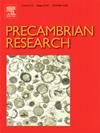Late Neoarchean magmatism and Paleoproterozoic metamorphism in the northern Yangtze Craton: Evidence from high-pressure mafic granulites of the Muzidian complex in the Dabie Orogen
IF 3.2
2区 地球科学
Q2 GEOSCIENCES, MULTIDISCIPLINARY
引用次数: 0
Abstract
Deciphering metamorphic evolution of high-pressure granulites developed in Palaeoproterozoic orogenic belt is crucial to understand plate tectonic mechanisms and evolutionary history in ancient cratons. In this study, we reported newly found mafic granulites from the Muzidian outcrop, which preserve a clockwise pressure–temperature-time (P–T–t) path. The prograde stage was suggested by inclusions of amphibole, plagioclase, quartz and clinopyroxene in garnet; the peak high pressure granulite facies stage was evidenced by garnet, clinopyroxene, amphibole, plagioclase, quartz and ilmenite, which was constrained in a P–T regime of 10.5–11.0 kbar/860–890 ℃. An early retrograde stage was recorded by orthopyroxene replacing clinopyroxene at P–T conditions of 5.5–7.0 kbar/820–850 ℃, while a later retrograde stage was revealed by the intergrowth of amphibolite and plagioclase in matrix at P–T conditions of 4.6–6.2 kbar/704–778 ℃. Zircon U-Pb dating for the mafic granulites yielded two age groups of ∼2.5 and 2.0 Ga, representing the formation ages of the magmatic protolith and the high pressure (HP) granulite facies metamorphism, respectively. The magmatic protolith zircons exhibit ɛHf(t) values from −8.3 to −0.9 with single-stage Hf model ages of ca. 3.1–2.8 Ga and high δ18O values from 9.39 ± 0.18 ‰ to 11.58 ± 0.11 ‰. These suggest the protoliths of the mafic granulites were likely derived from an enriched mantle that had been metasomatized by subducted crusatal materials. The metamorphic zircons have ɛHf(t) values from −8.6 to −0.3 and lower δ18O values from 8.11 ± 0.11 ‰ to 8.80 ± 0.15 ‰, suggesting that the metamorphosed zircons were formed at the granulite-facies metamorphism stage with external low δ18O and high ɛHf(t) melt/fluid. The clockwise P–T–t paths of the HP granulites suggest that the ca. 2.0 Ga arc-continent collision in the Yangtze craton has extended northward to the North Dabie Zone (NDZ). The Yangtze Craton might be situated in a key tectonic position between the southern margin of the Siberian Craton and the northern margin of Laurentia during the amalgamation of the Columbia supercontinent.
扬子克拉通北部晚新太古代岩浆作用与古元古代变质作用:来自大别造山带木子甸杂岩高压基性麻粒岩的证据
破译古元古代造山带高压麻粒岩的变质演化对了解古克拉通板块构造机制和演化历史具有重要意义。在这项研究中,我们报道了木子甸露头新发现的基性麻粒岩,它们保持顺时针的压力-温度-时间(P-T-t)路径。石榴石中含角闪石、斜长石、石英和斜辉石等包裹体,表明其处于递进阶段;高压麻粒岩相阶段以石榴石、斜辉石、角闪石、斜长石、石英和钛铁矿为特征,P-T范围为10.5 ~ 11.0 kbar/860 ~ 890℃。在5.5 ~ 7.0 kbar/820 ~ 850℃的P-T条件下,正辉石取代斜辉石出现了早期的逆行阶段;在4.6 ~ 6.2 kbar/704 ~ 778℃的P-T条件下,角闪石与斜长石在基质中共生,显示出较晚的逆行阶段。基性麻粒岩的锆石U-Pb定年结果为~ 2.5和2.0 Ga,分别代表岩浆原岩和高压麻粒岩相变质作用的形成时代。岩浆原岩锆石的α Hf(t)值为−8.3 ~−0.9,单期Hf模式年龄约为3.1 ~ 2.8 Ga, δ18O值为9.39±0.18‰~ 11.58±0.11‰。这些结果表明,基性麻粒岩的原岩可能来源于被俯冲地壳物质交代的富集地幔。变质锆石的δ Hf(t)值为−8.6 ~−0.3,δ18O值较低,为8.11±0.11‰~ 8.80±0.15‰,表明变质锆石形成于麻粒岩相变质阶段,外部δ18O低,熔体/流体高。HP麻粒岩的顺时针P-T-t路径表明,扬子克拉通约2.0 Ga的弧陆碰撞已向北扩展至北大别带。扬子克拉通可能处于哥伦比亚超大陆合并过程中西伯利亚克拉通南缘和劳伦西亚北缘之间的关键构造位置。
本文章由计算机程序翻译,如有差异,请以英文原文为准。
求助全文
约1分钟内获得全文
求助全文
来源期刊

Precambrian Research
地学-地球科学综合
CiteScore
7.20
自引率
28.90%
发文量
325
审稿时长
12 months
期刊介绍:
Precambrian Research publishes studies on all aspects of the early stages of the composition, structure and evolution of the Earth and its planetary neighbours. With a focus on process-oriented and comparative studies, it covers, but is not restricted to, subjects such as:
(1) Chemical, biological, biochemical and cosmochemical evolution; the origin of life; the evolution of the oceans and atmosphere; the early fossil record; palaeobiology;
(2) Geochronology and isotope and elemental geochemistry;
(3) Precambrian mineral deposits;
(4) Geophysical aspects of the early Earth and Precambrian terrains;
(5) Nature, formation and evolution of the Precambrian lithosphere and mantle including magmatic, depositional, metamorphic and tectonic processes.
In addition, the editors particularly welcome integrated process-oriented studies that involve a combination of the above fields and comparative studies that demonstrate the effect of Precambrian evolution on Phanerozoic earth system processes.
Regional and localised studies of Precambrian phenomena are considered appropriate only when the detail and quality allow illustration of a wider process, or when significant gaps in basic knowledge of a particular area can be filled.
 求助内容:
求助内容: 应助结果提醒方式:
应助结果提醒方式:


